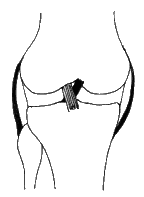
|
|||||||
Knee Ligament Injuries (Sprains)

What are knee ligament injuries?
The stability of the knee is dependent on powerful muscles which act as active restraints, and four strong ligaments which act as passive restraints.
The four ligaments are as follows.
- The medial collateral ligament (MCL) prevents the knee from buckling inwards (or valgus injury).
- The lateral collateral ligament (LCL) prevents the knee from buckling outwards (or varus injury).
- The anterior cruciate ligament (ACL) prevents the tibia from sliding forwards under the femur.
- The posterior cruciate ligament (PCL) prevents the tibia from sliding backwards under the femur
Together , these ligaments also provide rotatory stability to the knee, which is important in running sports like football and soccer where cutting (sudden change of direction while running at great speed) is often needed.
Ligament injuries (sprains) are classified according to severity as follows.
- Grade I - mild - where the ligament is stretched, but only a few fibers are disrupted
- Grade II - moderate - where the ligament is partially disrupted
- Grade III - severe - where the ligament is totally disrupted and there is instability.
What does your doctor do about knee ligament injuries?
Ligament injuries are very common in adults and mature adolescents, but less common in young children. In children, the ligaments are stronger than the epiphyeal plates ( growth plates), so that any extraneous force on the knee tends to disrupt the epiphyseal plate causing epiphyseal plate injuries rather than the ligaments.
X-rays will distinguish the epiphyseal plate injuries from the ligament injuries. Stress X-rays can help determine the severity of the ligament injury, and the stability of the knee. MRI may sometimes be needed to check for any other intra-articular injuries.
Grade I and II sprains can be treated conservatively with a cast or a brace followed by exercises to regain mobility and strength. (see the AirPro™ Basic Knee Support)
Grade III sprains usually require surgical repair followed by casting and intensive rehabilitation before the athlete can return to sports. This process may take about 12 weeks.
Cruciate ligament tears are not amenable to direct repair, and may require reconstruction at a later date. The decision to undertake reconstruction should be taken seriously, since the process of surgery and rehabilitation is arduous, and may take up to a year before return to sports. Factors to consider include age and aspirations of the patient.
NOTICE: The information presented is for your information only, and not a substitute for the medical advice of a qualified physician. Neither the author nor the publisher will be responsible for any harm or injury resulting from interpretations of the materials in this article.
Questions
or comments? Post your thoughts in the Orthoseek
Message Forum!
Find a pediatric orthopedic surgeon
in an area near you.
Home | About Us | Orthopaedic Topics | Message Forum
![]()
Comments, questions, or suggestions are welcome. Please
contact us using this form.